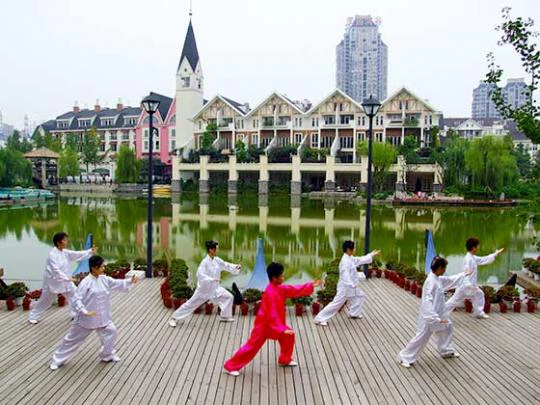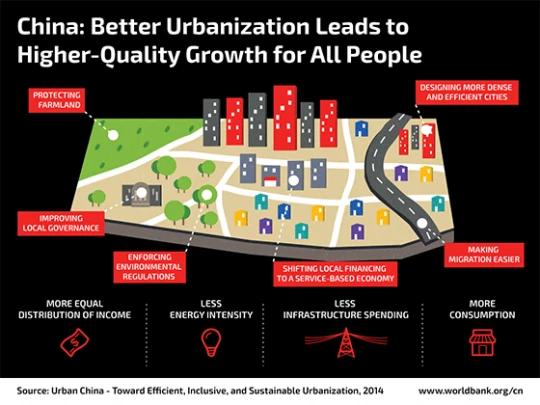
In 2030, more than 300 million Chinese are expected to have moved into cities. By then, 70 percent will live in urban settings. Given China’s size, it will mean that one in six urban dwellers worldwide will be Chinese. The challenges coming with that demographic shift are already visible and well known, in China and beyond.
Urbanization is a global trend. So when we think about new approaches to urbanization here in China, we believe that they are of value for other countries facing similar issues. In other words, China’s success in urbanization could pave the way for global rethinking on how cities can be built to be healthy, efficient, and successful.
Urbanization done well, and in particular, when it also addresses integrated urban-rural development, is essentially about sharing prosperity. It is critical for shifting a development model from focusing on quantity towards quality. It is about ensuring that the benefits of development and growth reach all citizens—whether they move to the mega cities, smaller towns, or live in a rural setting.
Urbanization can be an engine of growth—if handled well—but it needs attention and sound policies. Indeed, few countries reach high-income status without high levels of urbanization.
A joint study conducted by the World Bank Group and the Development Research Center of China’s State Council, recommends priorities to establish a new urbanization model that prioritizes reforming three areas: land management and ownership, the household registration system as well as urban and local government finances.
China needs denser, not larger, cities. The low-density urban sprawl has taken its toll, and the amount of farmland still available is close to the “red line” considered necessary to ensure food security. China should focus on efficient land use, document land rights for farmers, and improve compensation for rural land taken for urban construction. So far, most of that new urban land was taken from farmers with very low compensation, often no more than 20 percent of market prices. Paying farmers based on market prices would have prevented the large urban-rural inequality gap, a major source for social unrest in China today. It would have left more land for agricultural production and environmental preservation
Meanwhile, China should switch from the hukou, the origin-based registration system, to one based on residence. The 260 million migrants still excluded by the current system should have access to basic public services. Subsidies from the central government would help cities with the most number of migrants to make the transition into a residence-based system, with a nationwide standard for public services. It would also be important to make pension benefits portable across China. That will help ensure that people can move across China without a de-facto migration tax.
Reforms should change the source of local government revenues, now overly dependent on land-based financing. Cities can generate more stable revenues through measures such as housing and car taxes. The central government also should set up regulations so that cities can raise funds through bond markets and financial institutions for long-term investments. To discourage risky borrowing and shadow banking, the central government should impose hard budget constraints and set an explicit framework for local government borrowing.
One key element: local governments should be given incentives in their performance evaluation to enforce existing environmental laws and make sound decisions to foster an efficient, inclusive and sustainable urbanization process. We all know that China already has an impressive set of environmental regulations, but they should be effectively enforced. Local officials should also be encouraged to use market-based tools, such as taxes and trading systems for carbon, air and water pollution, to combat environmental degradation. That would also make economic sense: mortality and health problems caused by air pollution costs China as much as $300 billion a year.
That’s why new urbanization must be affordable and it will be. On current trends, China’s cities would spend some $5.3 trillion on infrastructure over the next fifteen years. But with more efficient, denser cities China can save some $1.4 trillion in infrastructure spending—or 15 percent of last year's GDP.
The urbanization agenda is undoubtedly ambitious, and it requires stamina, persistence and vision. The World Bank will continue to support China’s move in such a promising direction and continue its ongoing collaboration in climate change, promoting clean energy, reducing traffic jams and air pollution, and improving flood risk management.
The work ahead on urbanization is in line with the Bank’s major goals: ending poverty by 2030 and promoting shared prosperity. To achieve the latter it is critical to improve the lives of Chinese citizens and help the global effort in achieving sustainable and clean growth.
After the remarkable feat of lifting nearly half a billion people out of poverty in the last 30 years, China is ready to repeat this success in a key area of development: urbanization.
The good news is that the Chinese government is already implementing many of the recommendations of this joint study. The plans put people squarely at the center of reforms. This is a very strong sign that policy makers are not only recognizing the challenges, but also the opportunities that sound urbanization contributes to more and better growth.
If China succeeds, both the Chinese people and people worldwide will reap benefits.
 |
| Get the report: Urban China: Toward Efficient, Inclusive, and Sustainable Urbanization |


Join the Conversation